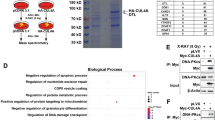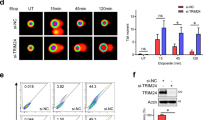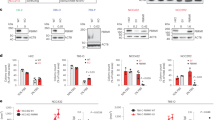Abstract
DNA repair is essential for maintaining genomic stability, and defects in this process significantly increase the risk of cancer. Clear-cell renal cell carcinoma (CCRCC) caused by inactivation of the von Hippel-Lindau (VHL) tumor suppressor gene is characterized by high genomic instability. However, the molecular mechanism underlying the association between the loss of VHL and genomic instability remains unclear. Here, we show that suppressor of cytokine signaling 1 (SOCS1) promotes nuclear redistribution and K63-ubiquitylation of VHL in response to DNA double-strand breaks (DSBs). Loss of VHL or VHL mutations that compromise its K63-ubiquitylation attenuates the DNA-damage response (DDR), resulting in decreased homologous recombination repair and persistence of DSBs. These results identify VHL as a component of the DDR network, inactivation of which contributes to the genomic instability associated with CCRCC.
This is a preview of subscription content, access via your institution
Access options
Subscribe to this journal
Receive 50 print issues and online access
$259.00 per year
only $5.18 per issue
Buy this article
- Purchase on Springer Link
- Instant access to full article PDF
Prices may be subject to local taxes which are calculated during checkout






Similar content being viewed by others
References
Lee JH, Paull TT . ATM activation by DNA double-strand breaks through the Mre11-Rad50-Nbs1 complex. Science 2005; 308: 551–554.
Bakkenist CJ, Kastan MB . DNA damage activates ATM through intermolecular autophosphorylation and dimer dissociation. Nature 2003; 421: 499–506.
Fernandez-Capetillo O, Lee A, Nussenzweig M, Nussenzweig A . H2AX: the histone guardian of the genome. DNA Repair (Amst) 2004; 3: 959–967.
Celeste A, Petersen S, Romanienko PJ, Fernandez-Capetillo O, Chen HT, Sedelnikova OA et al. Genomic instability in mice lacking histone H2AX. Science 2002; 296: 922–927.
Kastan MB, Lim DS . The many substrates and functions of ATM. Nat Rev Mol Cell Biol 2000; 1: 179–186.
Lavin MF, Kozlov S . ATM activation and DNA damage response. Cell Cycle 2007; 6: 931–942.
Bartek J, Lukas J . Chk1 and Chk2 kinases in checkpoint control and cancer. Cancer Cell 2003; 3: 421–429.
Delacote F, Han M, Stamato TD, Jasin M, Lopez BS . An xrcc4 defect or Wortmannin stimulates homologous recombination specifically induced by double-strand breaks in mammalian cells. Nucleic Acids Res 2002; 30: 3454–3463.
Allen C, Halbrook J, Nickoloff JA . Interactive competition between homologous recombination and non-homologous end joining. Mol Cancer Res 2003; 1: 913–920.
Couedel C, Mills KD, Barchi M, Shen L, Olshen A, Johnson RD et al. Collaboration of homologous recombination and nonhomologous end-joining factors for the survival and integrity of mice and cells. Genes Dev 2004; 18: 1293–1304.
Pierce AJ, Hu P, Han M, Ellis N, Jasin M . Ku DNA end-binding protein modulates homologous repair of double-strand breaks in mammalian cells. Genes Dev 2001; 15: 3237–3242.
Takata M, Sasaki MS, Sonoda E, Morrison C, Hashimoto M, Utsumi H et al. Homologous recombination and non-homologous end-joining pathways of DNA double-strand break repair have overlapping roles in the maintenance of chromosomal integrity in vertebrate cells. EMBO J 1998; 17: 5497–5508.
Fukushima T, Takata M, Morrison C, Araki R, Fujimori A, Abe M et al. Genetic analysis of the DNA-dependent protein kinase reveals an inhibitory role of Ku in late S-G2 phase DNA double-strand break repair. J Biol Chem 2001; 276: 44413–44418.
van Gent DC, Hoeijmakers JH, Kanaar R . Chromosomal stability and the DNA double-stranded break connection. Nat Rev Genet 2001; 2: 196–206.
Shiloh Y, Kastan MB . ATM: genome stability, neuronal development, and cancer cross paths. Adv Cancer Res 2001; 83: 209–254.
Stewart GS, Maser RS, Stankovic T, Bressan DA, Kaplan MI, Jaspers NG et al. The DNA double-strand break repair gene hMRE11 is mutated in individuals with an ataxia-telangiectasia-like disorder. Cell 1999; 99: 577–587.
O'Donovan PJ, Livingston DM . BRCA1 and BRCA2: breast/ovarian cancer susceptibility gene products and participants in DNA double-strand break repair. Carcinogenesis 2010; 31: 961–967.
Arai E, Kanai Y . Genetic and epigenetic alterations during renal carcinogenesis. Int J Clin Exp Pathol 2011; 4: 58–73.
Varela I, Tarpey P, Raine K, Huang D, Ong CK, Stephens P et al. Exome sequencing identifies frequent mutation of the SWI/SNF complex gene PBRM1 in renal carcinoma. Nature 2011; 469: 539–542.
Ivan M, Kondo K, Yang H, Kim W, Valiando J, Ohh M et al. HIFalpha targeted for VHL-mediated destruction by proline hydroxylation: implications for O2 sensing. Science 2001; 292: 464–468.
Jaakkola P, Mole DR, Tian YM, Wilson MI, Gielbert J, Gaskell SJ et al. Targeting of HIF-alpha to the von Hippel-Lindau ubiquitylation complex by O2-regulated prolyl hydroxylation. Science 2001; 292: 468–472.
Wang Y, Roche O, Yan MS, Finak G, Evans AJ, Metcalf JL et al. Regulation of endocytosis via the oxygen-sensing pathway. Nat Med 2009; 15: 319–324.
Bluyssen HA, Lolkema MP, van Beest M, Boone M, Snijckers CM, Los M et al. Fibronectin is a hypoxia-independent target of the tumor suppressor VHL. FEBS Lett 2004; 556: 137–142.
Ohh M, Yauch RL, Lonergan KM, Whaley JM, Stemmer-Rachamimov AO, Louis DN et al. The von Hippel-Lindau tumor suppressor protein is required for proper assembly of an extracellular fibronectin matrix. Mol Cell 1998; 1: 959–968.
Schermer B, Ghenoiu C, Bartram M, Müller RU, Kotsis F, Höhne M et al. The von Hippel-Lindau tumor suppressor protein controls ciliogenesis by orienting microtubule growth. J Cell Biol 2006; 175: 547–554.
Young AP, Schlisio S, Minamishima YA, Zhang Q, Li L, Grisanzio C et al. VHL loss actuates a HIF-independent senescence programme mediated by Rb and p400. Nat Cell Biol 2008; 10: 361–369.
Russell RC, Sufan RI, Zhou B, Heir P, Bunda S, Sybingco SS et al. Loss of JAK2 regulation via a heterodimeric VHL-SOCS1 E3 ubiquitin ligase underlies Chuvash polycythemia. Nat Med 2011; 17: 845–853.
Calabrese V, Mallette FA, Deschênes-Simard X, Ramanathan S, Gagnon J, Moores A et al. SOCS1 links cytokine signaling to p53 and senescence. Mol Cell 2009; 36: 754–767.
Ben-Zvi T, Yayon A, Gertler A, Monsonego-Ornan E . Suppressors of cytokine signaling (SOCS) 1 and SOCS3 interact with and modulate fibroblast growth factor receptor signaling. J Cell Sci 2006; 119: 380–387.
Lee S, Chen DY, Humphrey JS, Gnarra JR, Linehan WM, Klausner RD . Nuclear/cytoplasmic localization of the von Hippel-Lindau tumor suppressor gene product is determined by cell density. Proc Natl Acad Sci USA 1996; 93: 1770–1775.
Cai Q, Robertson ES . Ubiquitin/SUMO modification regulates VHL protein stability and nucleocytoplasmic localization. PLoS One 2010; 5: e12636.
Stickle NH, Chung J, Klco JM, Hill RP, Kaelin WG, Ohh M . pVHL modification by NEDD8 is required for fibronectin matrix assembly and suppression of tumor development. Mol Cell Biol 2004; 24: 3251–3261.
Ungureanu D, Saharinen P, Junttila I, Hilton DJ, Silvennoinen O . Regulation of Jak2 through the ubiquitin-proteasome pathway involves phosphorylation of Jak2 on Y1007 and interaction with SOCS-1. Mol Cell Biol 2002; 22: 3316–3326.
Peng J, Schwartz D, Elias JE, Thoreen CC, Cheng D, Marsischky G et al. A proteomics approach to understanding protein ubiquitination. Nat Biotechnol 2003; 21: 921–926.
Panier S, Durocher D . Regulatory ubiquitylation in response to DNA double-strand breaks. DNA Repair (Amst) 2009; 8: 436–443.
Zhao GY, Sonoda E, Barber LJ, Oka H, Murakawa Y, Yamada K et al. A critical role for the ubiquitin-conjugating enzyme Ubc13 in initiating homologous recombination. Mol Cell 2007; 25: 663–675.
Stewart GS, Panier S, Townsend K, Al-Hakim AK, Kolas NK, Miller ES et al. The RIDDLE syndrome protein mediates a ubiquitin-dependent signaling cascade at sites of DNA damage. Cell 2009; 136: 420–434.
Kim JS, Krasieva TB, Kurumizaka H, Chen DJ, Taylor AM, Yokomori K . Independent and sequential recruitment of NHEJ and HR factors to DNA damage sites in mammalian cells. J Cell Biol 2005; 170: 341–347.
Weinstock DM, Nakanishi K, Helgadottir HR, Jasin M . Assaying double-strand break repair pathway choice in mammalian cells using a targeted endonuclease or the RAG recombinase. Methods Enzymol 2006; 409: 524–540.
Lee S, Neumann M, Stearman R, Stauber R, Pause A, Pavlakis GN et al. Transcription-dependent nuclear-cytoplasmic trafficking is required for the function of the von Hippel-Lindau tumor suppressor protein. Mol Cell Biol 1999; 19: 1486–1497.
Lewis MD, Roberts BJ . Role of nuclear and cytoplasmic localization in the tumour-suppressor activity of the von Hippel-Lindau protein. Oncogene 2003; 22: 3992–3997.
Plans V, Scheper J, Soler M, Loukili N, Okano Y, Thomson TM et al. The RING finger protein RNF8 recruits UBC13 for lysine 63-based self polyubiquitylation. J Cell Biochem 2006; 97: 572–582.
Christensen DE, Brzovic PS, Klevit RE . E2-BRCA1 RING interactions dictate synthesis of mono- or specific polyubiquitin chain linkages. Nat Struct Mol Biol 2007; 14: 941–948.
Hofmann RM, Pickart CM . Noncanonical MMS2-encoded ubiquitin-conjugating enzyme functions in assembly of novel polyubiquitin chains for DNA repair. Cell 1999; 96: 645–653.
Riballo E, Kühne M, Rief N, Doherty A, Smith GC, Recio MJ et al. A pathway of double-strand break rejoining dependent upon ATM, Artemis, and proteins locating to gamma-H2AX foci. Mol Cell 2004; 16: 715–724.
Koshiji M, To KK, Hammer S, Kumamoto K, Harris AL, Modrich P et al. HIF-1alpha induces genetic instability by transcriptionally downregulating MutSalpha expression. Mol Cell 2005; 17: 793–803.
Rezvani HR, Mahfouf W, Ali N, Chemin C, Ged C, Kim AL et al. Hypoxia-inducible factor-1alpha regulates the expression of nucleotide excision repair proteins in keratinocytes. Nucleic Acids Res 2009; 38: 797–809.
Qi H, Ohh M . The von Hippel-Lindau tumor suppressor protein sensitizes renal cell carcinoma cells to tumor necrosis factor-induced cytotoxicity by suppressing the nuclear factor-kappaB-dependent antiapoptotic pathway. Cancer Res 2003; 63: 7076–7080.
Roberts AM, Watson IR, Evans AJ, Foster DA, Irwin MS, Ohh M et al. Suppression of hypoxia-inducible factor 2alpha restores p53 activity via Hdm2 and reverses chemoresistance of renal carcinoma cells. Cancer Res 2009; 69: 9056–9064.
Yang H, Minamishima YA, Yan Q, Schlisio S, Ebert BL, Zhang X et al. pVHL acts as an adaptor to promote the inhibitory phosphorylation of the NF-kappaB agonist Card9 by CK2. Mol Cell 2007; 28: 15–27.
Hoffman MA, Ohh M, Yang H, Klco JM, Ivan M, Kaelin WG et al. von Hippel-Lindau protein mutants linked to type 2C VHL disease preserve the ability to downregulate HIF. Hum Mol Genet 2001; 10: 1019–1027.
Mendez J, Stillman B . Chromatin association of human origin recognition complex, cdc6, and minichromosome maintenance proteins during the cell cycle: assembly of prereplication complexes in late mitosis. Mol Cell Biol 2000; 20: 8602–8612.
Evans AJ, Russell RC, Roche O, Burry TN, Fish JE, Chow VW et al. VHL promotes E2 box-dependent E-cadherin transcription by HIF-mediated regulation of SIP1 and snail. Mol Cell Biol 2007; 27: 157–169.
Acknowledgements
This work was supported by funds from the Canadian Institutes of Health Research (MOP77718).
Author information
Authors and Affiliations
Corresponding author
Ethics declarations
Competing interests
The authors declare no conflict of interest.
Additional information
Supplementary Information accompanies the paper on the Oncogene website
Rights and permissions
About this article
Cite this article
Metcalf, J., Bradshaw, P., Komosa, M. et al. K63-Ubiquitylation of VHL by SOCS1 mediates DNA double-strand break repair. Oncogene 33, 1055–1065 (2014). https://doi.org/10.1038/onc.2013.22
Received:
Revised:
Accepted:
Published:
Issue Date:
DOI: https://doi.org/10.1038/onc.2013.22
Keywords
This article is cited by
-
Role of K63-linked ubiquitination in cancer
Cell Death Discovery (2022)
-
Clear cell renal cell carcinoma ontogeny and mechanisms of lethality
Nature Reviews Nephrology (2021)
-
E3 ligase TRIM25 ubiquitinates RIP3 to inhibit TNF induced cell necrosis
Cell Death & Differentiation (2021)
-
Cullin 5 is a novel candidate tumor suppressor in renal cell carcinoma involved in the maintenance of genome stability
Oncogenesis (2019)
-
Loss of PBRM1 rescues VHL dependent replication stress to promote renal carcinogenesis
Nature Communications (2017)



